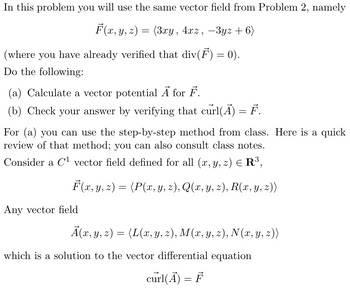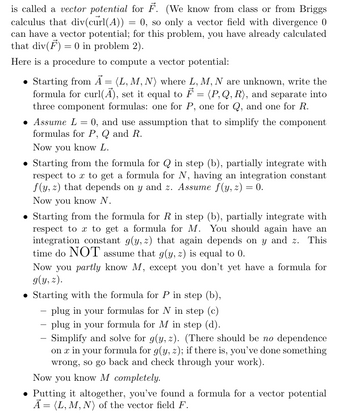
Advanced Engineering Mathematics
10th Edition
ISBN: 9780470458365
Author: Erwin Kreyszig
Publisher: Wiley, John & Sons, Incorporated
expand_more
expand_more
format_list_bulleted
Question

Transcribed Image Text:In this problem you will use the same vector field from Problem 2, namely
F(x, y, z) = (3xy, 4xz, -3yz+6)
(where you have already verified that div(F) = 0).
Do the following:
(a) Calculate a vector potential Ā for F.
(b) Check your answer by verifying that curl(A) = F.
For (a) you can use the step-by-step method from class. Here is a quick
review of that method; you can also consult class notes.
Consider a C¹ vector field defined for all (x, y, z) = R³,
F(x, y, z) = (P(x, y, z), Q(x, y, z), R(x, y, z))
Any vector field
A(x, y, z) = (L(x, y, z), M(x, y, z), N(x, y, z))
which is a solution to the vector differential equation
curl(A) = F

Transcribed Image Text:is called a vector potential for F. (We know from class or from Briggs
calculus that div(curl(A)) 0, so only a vector field with divergence 0
=
can have a vector potential; for this problem, you have already calculated
that div(F) = 0 in problem 2).
Here is a procedure to compute a vector potential:
=
Starting from A (L, M, N) where L, M, N are unknown, write the
formula for curl(Ã), set it equal to ♬ = (P,Q,R), and separate into
three component formulas: one for P, one for Q, and one for R.
• Assume L = 0, and use assumption that to simplify the component
formulas for P, Q and R.
Now you know L.
Starting from the formula for Q in step (b), partially integrate with
respect to x to get a formula for N, having an integration constant
f(y, z) that depends on y and z. Assume f(y, z) = 0.
Now you know N.
Starting from the formula for R in step (b), partially integrate with
respect to x to get a formula for M. You should again have an
integration constant g(y, z) that again depends on y and z. This
time do NOT assume that g(y, z) is equal to 0.
Now you partly know M, except you don't yet have a formula for
g(y, z).
Starting with the formula for P in step (b),
-plug in your formulas for N in step (c)
-plug in your formula for M in step (d).
-
Simplify and solve for g(y, z). (There should be no dependence
on x in your formula for g(y, z); if there is, you've done something
wrong, so go back and check through your work).
Now you know M completely.
⚫ Putting it altogether, you've found a formula for a vector potential
A = (L, M, N) of the vector field F.
Expert Solution
This question has been solved!
Explore an expertly crafted, step-by-step solution for a thorough understanding of key concepts.
Step by stepSolved in 2 steps with 8 images

Knowledge Booster
Similar questions
- Find the directional derivative of f(x, y) = x/y at the point (4, 4) in the direction of the vector v = (5, –4). If you didn't get the right answer, it is probably not a syntax error. There is something different in this problem than the previous ones.arrow_forwardIf A = yz(^2) i - 3xz(^2) j + 2xyz k , B = 3x i + 4z j - xy k and ∅= xyz , find (a) Ax (∇∅), (b) (Ax ∇) ∅, (c) (∇x A) x B, (d) B. ∇x A.arrow_forwardHow would I write a vector function r(t) that follows the below guidelinesarrow_forward
- B = ①check that div (B) = 0 ②Find a vector potential for B.arrow_forwardA net is dipped in a river. Determine the flow rate of water across the net if the velocity vector field for the river is given by v=(x-y,z+y+7,z2) and the net is decribed by the equation y=1-x2-z2, y20, and oriented in the positive y- direction. (Use symbolic notation and fractions where needed.)arrow_forwardSuppose that r1(t) and r2(t) are vector-valued functions in 2-space. Explain why solving the equation r1(t)=r2(t) may not produce all the points where the graphs of these functions intersect. Please Provide Unique Answer. Thank you!arrow_forward
- 2) Let 7(t) = (t, t², e'). Find an equation for the unit tangent vector T(t).arrow_forwardA particle is moving with velocity V(t) = ( pi cos (pi t), 3t2+ 1) m/s for 0 ≤ t ≤ 10 seconds. Given that the position of the particle at time t = 2s is r(2) = (3, -2), the position vector of the particle at t is?arrow_forwardSuppose f(x, y) = sin (a) ▼ f(x, y) = = 2y X 2y cos 2y 2y 2 cos (2) (2) X - X (b) ▼ƒ(3, π) = 77, 17/0 9' and u is the unit vector in the direction of (1, 1). Then, V (c) fu (3, π) = Du ƒ(3, π) = 0arrow_forward
- I am confused on this question. I took the derivative of each section and plugged in 4 and it told me a line cannot be a constant vector. I got L(t)=<10, -1/4, 1>. I am not quit understanding.arrow_forwardAnswer both remaining part in 10 minutes in the order to get positive feedbackarrow_forward4. Consider the motion of a particle as described by 1 1 r(t) = = t, Write the acceleration vector of this particle at time t = 1 as a = a+T+ anÑ. You do not need to find T and Ñ, but you can if you find it helpful.arrow_forward
arrow_back_ios
SEE MORE QUESTIONS
arrow_forward_ios
Recommended textbooks for you
 Advanced Engineering MathematicsAdvanced MathISBN:9780470458365Author:Erwin KreyszigPublisher:Wiley, John & Sons, Incorporated
Advanced Engineering MathematicsAdvanced MathISBN:9780470458365Author:Erwin KreyszigPublisher:Wiley, John & Sons, Incorporated Numerical Methods for EngineersAdvanced MathISBN:9780073397924Author:Steven C. Chapra Dr., Raymond P. CanalePublisher:McGraw-Hill Education
Numerical Methods for EngineersAdvanced MathISBN:9780073397924Author:Steven C. Chapra Dr., Raymond P. CanalePublisher:McGraw-Hill Education Introductory Mathematics for Engineering Applicat...Advanced MathISBN:9781118141809Author:Nathan KlingbeilPublisher:WILEY
Introductory Mathematics for Engineering Applicat...Advanced MathISBN:9781118141809Author:Nathan KlingbeilPublisher:WILEY Mathematics For Machine TechnologyAdvanced MathISBN:9781337798310Author:Peterson, John.Publisher:Cengage Learning,
Mathematics For Machine TechnologyAdvanced MathISBN:9781337798310Author:Peterson, John.Publisher:Cengage Learning,


Advanced Engineering Mathematics
Advanced Math
ISBN:9780470458365
Author:Erwin Kreyszig
Publisher:Wiley, John & Sons, Incorporated

Numerical Methods for Engineers
Advanced Math
ISBN:9780073397924
Author:Steven C. Chapra Dr., Raymond P. Canale
Publisher:McGraw-Hill Education

Introductory Mathematics for Engineering Applicat...
Advanced Math
ISBN:9781118141809
Author:Nathan Klingbeil
Publisher:WILEY

Mathematics For Machine Technology
Advanced Math
ISBN:9781337798310
Author:Peterson, John.
Publisher:Cengage Learning,

